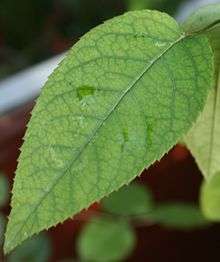Manganese deficiency (plant)
Manganese (Mn) deficiency is a plant disorder that is often confused with, and occurs with, iron deficiency. Most common in poorly drained soils, also where organic matter levels are high. Manganese may be unavailable to plants where pH is high.

Affected plants include onion, apple, peas, French beans, cherry and raspberry, and symptoms include yellowing of leaves with smallest leaf veins remaining green to produce a ‘chequered’ effect. The plant may seem to grow away from the problem so that younger leaves may appear to be unaffected. Brown spots may appear on leaf surfaces, and severely affected leaves turn brown and wither.
Prevention can be achieved by improving soil structure. Do not over-lime.
Symptoms
Manganese deficiency can be easy to spot in plants because, much like magnesium deficiency, the leaves start to turn yellow and undergo interveinal chlorosis. The difference between these two is that the younger leaves near the top of the plant show symptoms first because manganese is not mobile while in magnesium deficiency show symptoms in older leaves near the bottom of the plant.[1]
Treatment
Manganese deficiency is easy to cure and homeowners have several options when treating these symptoms. The first is to adjust the soil pH. Two materials commonly used for lowering the soil pH are ammonium sulfate and sulfur. Ammonium sulfate will change the soil pH instantly because the ammonium produces the acidity as soon as it dissolves in the soil. Sulfur, however, requires some time for the conversion to sulfuric acid by soil bacteria. If the soil pH is not a problem and there is no manganese in the soil then Foliar feeding for small plants and Medicaps for large trees are both common ways for homeowners to get manganese into the plant.[2]
References
- Wallace, Thomas. The diagnosis of mineral deficiencies in plants by visual symptoms. A colour atlas and guide.. H.M. Stationery Office, London, 1943, p. 1.
- Messenger, A. Steven. Response of interveinally chlorotic red maple trees treated with medicaps or by soil acidification. J. Environ, 1990, p. 2.